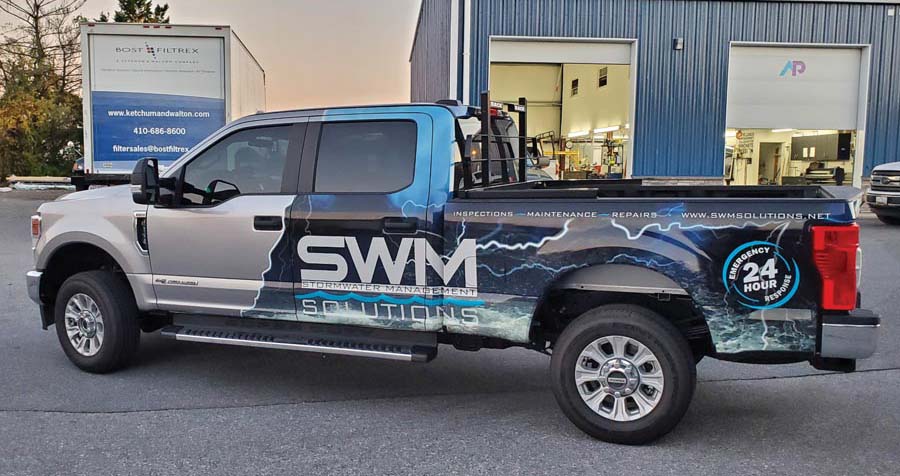A contractor’s vehicle is portable real estate that can serve as a rolling billboard. Contractors and truck wrap experts have striking success stories about revamping HVAC vehicles as marketing weapons. Still, general economic uncertainty makes for uncertain cash flow, so it makes sense to talk expenses first.
Money Matters
Typical wraps depend on the square footage to be wrapped. Multiple-vehicle discounts might bring costs down, depending on the vendor, while the complexity of a given vehicle might raise them a bit.
Between $3,500 and $4,500 per vehicle is a decent general range, according to Dan Antonelli, president and CEO of KickCharge Creative.
That expense might not have a line item ready and waiting in many contractors’ marketing budgets. Bryan Kratz, digital media strategist for AP Graphics, which offers window film and graphics solutions, said some of AP’s customers come at it from a different angle.
“Many of our customers factor in the price of a wrap when purchasing vehicles for their fleet,” which is more likely to be an expected annual cost.
Antonelli positions the wraps as part of a larger investment in establishing a brand.
“Ideally, that brand investment should last a lifetime, and then the vehicles themselves should generally have a shelf life of five years.”
Contractors can use that estimate to establish the true cost per year; larger companies may enjoy an economy of scale. Either way, Antonelli would expect wrap costs to run less than 1% of overall budget.
A natural next question for many contractors is how to tell if it’s worth it.
“Quantifying the effects of any form of advertising can be difficult,” said Kratz.
Still, determining the effect of new wraps isn’t totally abstract, either. Using a particular phone number on the vehicles can let contractors track success, Kratz said, adding that customers have used dedicated landing pages in the same way.
Antonelli recommends making sure that CSRs are asking “How did you hear about us?” on inbound calls. He noted that contractors can often use a lead source option in their CRM software, then track the revenue from that source.
“This is where you see ROI with some clarity, although it’s still not exact,” he said.
Exact or not, Kratz said that most commonly, the results become apparent quickly. He did add that owners might skip investing in a new wrap for any vehicle that is in poor shape.
“This would be any chipping paint, big dents or scratches, or a vehicle you plan to replace in the next year or two.”
Colors and Content
Bold primary colors … pastels … do some color trends come and go in popularity, like interior house colors?
“Definitely!” answered Kratz. “Looking back, there were some color schemes more popular in the 1980s that wouldn’t work as well now, and vice versa.”
Most often, though, Kratz said AP’s team designs wraps to stay consistent with client branding and logos.
KickCharge will come at that task from a competitive standpoint as well. Context matters.
“If there’s a plethora of red- and blue-branded trucks in that market,” Antonelli explained, “there is no way I’m going to add yet another one.”
The goal is to keep your colors from fading, so to speak — people should know just by seeing the colors alone that the vehicle represents a contractor’s particular brand.
Of course, the base colors may catch the eye, but the eye wants to keep looking and reading. Don’t ask those eyeballs to do too much.
“The biggest mistake we see is when a contractor wants to cram too many certifications, five-star reviews, awards, etc. onto the wrap,” Kratz said. The result is that each component then becomes too small.
“You only have eight to 10 seconds to make an impression with your wrap, so size matters!”
Antonelli agreed that too much information is the most common mistake, but not the only one. Contractors can include photography or extraneous images with the intent of increasing interest, but in Antonelli’s assessment, “Photography is always a crutch for poor branding.”
Images of equipment can put too much emphasis on the “what” and not the “who” you are trying to emphasize, while concepts reflecting the owner’s likes (or dislikes) may not necessarily align with customer tastes.
“We find stock imagery tends to date itself much faster than branded designs without imagery,” Kratz added to the no-photography argument. AP Graphics often sticks to logos and large design elements instead.
Antonelli says that “simple, easy to read, brand-centric, and memorable” sums up the perfect wrap.
Processes and Tipping Points
When it comes to working with companies who do this kind of work, the actual process “really depends on the client,” Kratz said.
His large-fleet customers tend to know what they want. They are just looking for someone to coordinate the designs, print, and installation. Smaller contractors, on the other hand, are more likely to be new to the product and may require more back-and-forth.

Antonelli said that KickCharge typically presents two to three options, and the client chooses one.
“Again, the options are going to be based on competitive analysis, and the ability to be disruptive and unique in the market,” he said. Antonelli pointed to McQuillan Brothers, a plumbing and HVAC company in the Minneapolis/St. Paul area. In their case, the search for something atypical and effective was a brown and orange combination.
KickCharge rarely works with a client’s existing logo, and Antonelli is straightforward in explaining that that’s because most do not have an established brand worth wrapping.
“You need to first fix the foundation before you start implementing it across the board.”
That brings the story to a somewhat surprising twist. Some might assume that a contractor would have a brand/logo or undertake a brand overhaul, then take the results to the vehicle wrap vendor. That does happen. However, both Antonelli and Kratz report that often, a client realizes that a brand and logo (old or new) is not vibrant enough or just doesn’t work well when it gets into a truck wrap environment.
Other times, Antonelli said, customers get in touch because “they simply realize they don’t have a brand. They are having trouble growing, investing more and more on other marketing channels, and getting nowhere. They are having trouble recruiting because the company doesn’t look professional.”
Being seen is only half the challenged, he said, and it doesn’t mean much if the brand is not also delivering a positive brand promise.
What does that promise mean? That the consumer believes and expects something about the deliverable before the doorbell rings.
“Having a consumer believe the service they are going to get will be exceptional. That’s what great brands do.”
The motivation for initiating a truck wrap can also be much more direct. In Kratz’ experience, the most common tipping point is “when their competitor or someone else they know gets a gorgeous new wrap.
“You hear them say, ‘I saw that this plumber on a new job got a new wrap, and I asked them about it to see how well it is working.’”
Cases In Point
Both AP Graphics and KickCharge Creative can pull up good case studies across different trades. Asked for a distinctive AP Graphics project, Kratz picked Stormwater Management. That company wanted trucks to be similar to existing vehicles, but it only had a budget for partial wraps.

“We decided to use a lightning bolt they already used in their design to cut off the wrap,” he said. “It worked beautifully and felt like a natural progression of their brand — just a little more deliberate.”
Antonelli recalls another budget-sensitive case involving Gem Plumbing. There, KickCharge helped the company improve on an old wrap, but only on 25% of the fleet.
He reports that the company saw quadruple the number of calls attributed to the trucks. Extrapolating the potential gain of a fleet-wide revamp, Gem is in the process of wrapping its other vehicles.
It’s A Wrap
After so many years of “conventional” looking contractor trucks on the road, a wrap may often still feel like an extra. Predictably but persuasively, Kratz disagrees, calling a wrap “one of the first types of advertising any contractor should invest in after uniforms and business cards.”
HVAC vehicles are with installers and techs all day, he emphasized, from job sites to parking lots and traffic lights.
As more contractors embrace these modern option for marketing with their vehicles, Antonelli and Kratz already have a sense of what’s next for wraps. The wheels themselves are rarely affected, but Antonelli confirms they have put color on them for certain designs.
Kratz sees taking today’s eye-catching colors and raising their profile even more.
“The next frontier is reflective vinyl wraps,” he said. The reflective vinyl can add “an extra pop of attention you need when the sun goes down.”
Similar to what people are used to seeing on an ambulance or a safety vest, the reflective component doesn’t go over the complete wrap, just on key elements of the design.
“This lets a business command attention to their brand, day or night.”











